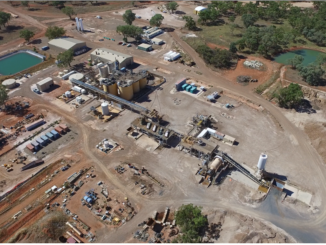Manuka Resources has an estimated 400 to 500 megalitres of water to give away from the pit at the Mount Boppy Mine at Canbelego, however red tape is holding them up.
Manuka Resources’ Chief Operations Officer Haydn Lynch said the company has plans to mine the open pit at Mount Boppy once again but first it needs to be dewatered, either pre mining or while they’re mining.
“There’s always a natural flow into the pit from groundwater and we’re using a submersible pump to discharge that into a small, very shallow dam off the western side of the pit.
“During summer that all evaporates pretty rapidly,” Mr Lynch said.
“Our story is probably replicated dozens, if not hundreds of times, across Australia with shallow open pit mines who have a great source of water that no one is really looking at because they all think it’s a bit too hard.
“What we’re going to do at Mount Boppy mine is fairly short. We’ve probably only got about 12 months of open pit mining left there then it will go back to an exploration site.
“Over the next few years it’ll fill up with water again from natural rainfall.”
He said it could be a good source of water for the community as the pit is always going to be there.
Manuka Resources has been working for the past five months to vary their environmental licence with the EPA (Environmental Protection Agency) in an effort to find “a better home” for the water.
“We had discussions with the local landowners, all the mines in the Cobar region who were running short on processed water and then we went ahead and formalised our water sampling at Mount Boppy,” Mr Lynch said.
Independent testing carried out in October this year showed the water quality at 10 metre, 20m and 30m metre depths had been “remarkably consistent all the way through”.
“Ours is very neutral, there’s no nasties, it is actually good water,” Mr Lynch said.
“The water quality meets the criteria for stock watering [as per the Australian and New Zealand Guidelines for Fresh and Marine Water Guidelines ANZECC 2000].
“You can put it on the ground, you can certainly use it for processed water, you can use it pretty much in all industrial applications.”
The company is not looking to sell the water, just recover diesel costs for pumping the water.
A neighbour, who has not received any consistent rainfall for several years, is very interested in obtaining the water. He said having the water for use on his sheep and cattle grazing property would be “beneficial beyond words”.
Mr Lynch has made contact with a number of NSW State Ministers through the Department of Premier and Cabinet in an effort to find someone to help them navigate the red tape.
“We’re having mixed success,” he said.
“I think what we’re proposing is pretty sensible, we’ve gone about it properly.
“As we stand today we still don’t have licence variation from the EPA.
“I’m hoping the EPA will come through formalising what they’ve told us verbally and we can move on but we don’t currently have that.”
Mr Lynch said the latest correspondence from EPA on Monday has advised the proposed discharge of water would require development consent from Cobar Shire Council before they can consider a licence variation.
That process could take up to three months and by that time the water will be evaporated.
EPA has also called for a further 11 water tests to be carried out.

